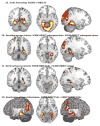The effect of scene context on episodic object recognition: parahippocampal cortex mediates memory encoding and retrieval success
- PMID: 17604348
- PMCID: PMC3615418
- DOI: 10.1002/hipo.20319
The effect of scene context on episodic object recognition: parahippocampal cortex mediates memory encoding and retrieval success
Abstract
Previous research has investigated intentional retrieval of contextual information and contextual influences on object identification and word recognition, yet few studies have investigated context effects in episodic memory for objects. To address this issue, unique objects embedded in a visually rich scene or on a white background were presented to participants. At test, objects were presented either in the original scene or on a white background. A series of behavioral studies with young adults demonstrated a context shift decrement (CSD)-decreased recognition performance when context is changed between encoding and retrieval. The CSD was not attenuated by encoding or retrieval manipulations, suggesting that binding of object and context may be automatic. A final experiment explored the neural correlates of the CSD, using functional Magnetic Resonance Imaging. Parahippocampal cortex (PHC) activation (right greater than left) during incidental encoding was associated with subsequent memory of objects in the context shift condition. Greater activity in right PHC was also observed during successful recognition of objects previously presented in a scene. Finally, a subset of regions activated during scene encoding, such as bilateral PHC, was reactivated when the object was presented on a white background at retrieval. Although participants were not required to intentionally retrieve contextual information, the results suggest that PHC may reinstate visual context to mediate successful episodic memory retrieval. The CSD is attributed to automatic and obligatory binding of object and context. The results suggest that PHC is important not only for processing of scene information, but also plays a role in successful episodic memory encoding and retrieval. These findings are consistent with the view that spatial information is stored in the hippocampal complex, one of the central tenets of Multiple Trace Theory.
(c) 2007 Wiley-Liss, Inc.
Figures






Similar articles
-
Neural mechanisms of context effects on face recognition: automatic binding and context shift decrements.J Cogn Neurosci. 2010 Nov;22(11):2541-54. doi: 10.1162/jocn.2009.21379. J Cogn Neurosci. 2010. PMID: 19925208 Free PMC article.
-
Selective neural representation of objects relevant for navigation.Nat Neurosci. 2004 Jun;7(6):673-7. doi: 10.1038/nn1257. Epub 2004 May 16. Nat Neurosci. 2004. PMID: 15146191
-
False memory for context and true memory for context similarly activate the parahippocampal cortex.Cortex. 2017 Jun;91:79-88. doi: 10.1016/j.cortex.2017.02.007. Epub 2017 Feb 24. Cortex. 2017. PMID: 28318498
-
[Functional neuroimaging studies of episodic memory--functional dissociation in the medial temporal lobe structures].Brain Nerve. 2008 Jul;60(7):833-44. Brain Nerve. 2008. PMID: 18646623 Review. Japanese.
-
The role of the parahippocampal cortex in cognition.Trends Cogn Sci. 2013 Aug;17(8):379-90. doi: 10.1016/j.tics.2013.06.009. Epub 2013 Jul 10. Trends Cogn Sci. 2013. PMID: 23850264 Free PMC article. Review.
Cited by
-
Different types of associative encoding evoke differential processing in both younger and older adults: Evidence from univariate and multivariate analyses.Neuropsychologia. 2019 Dec;135:107240. doi: 10.1016/j.neuropsychologia.2019.107240. Epub 2019 Nov 2. Neuropsychologia. 2019. PMID: 31682927 Free PMC article.
-
The extraction of natural scene gist in visual crowding.Sci Rep. 2018 Sep 19;8(1):14073. doi: 10.1038/s41598-018-32455-6. Sci Rep. 2018. PMID: 30232470 Free PMC article.
-
Event-related potential index of age-related differences in memory processes in adults with Down syndrome.Neurobiol Aging. 2014 Jan;35(1):247-53. doi: 10.1016/j.neurobiolaging.2013.07.024. Epub 2013 Aug 29. Neurobiol Aging. 2014. PMID: 23993703 Free PMC article.
-
Does scene context always facilitate retrieval of visual object representations?Psychon Bull Rev. 2011 Apr;18(2):309-15. doi: 10.3758/s13423-010-0045-x. Psychon Bull Rev. 2011. PMID: 21327383
-
Examining gray matter structures associated with individual differences in global life satisfaction in a large sample of young adults.Soc Cogn Affect Neurosci. 2015 Jul;10(7):952-60. doi: 10.1093/scan/nsu144. Epub 2014 Nov 17. Soc Cogn Affect Neurosci. 2015. PMID: 25406366 Free PMC article.
References
-
- Aggleton JP, Brown MW. Episodic memory, amnesia, and the hippocampal-anterior thalamic axis. Behavioral and Brain Sciences. 1999;22(3):425–489. - PubMed
-
- Aguirre GK, Detre JA, Alsop DC, D’Esposito M. The parahippocampus subserves topographical learning in man. Cerebral Cortex. 1996;6(6):823–829. - PubMed
-
- Bar M. A cortical mechanism for triggering top-down facilitation in object recognition. Journal of Cognitive Neuroscience. 2003;15(4):600–609. - PubMed
-
- Bar M. Visual objects in context. Nature Reviews: Neuroscience. 2004;5:617–629. - PubMed
Publication types
MeSH terms
Substances
Grants and funding
LinkOut - more resources
Full Text Sources
Medical

